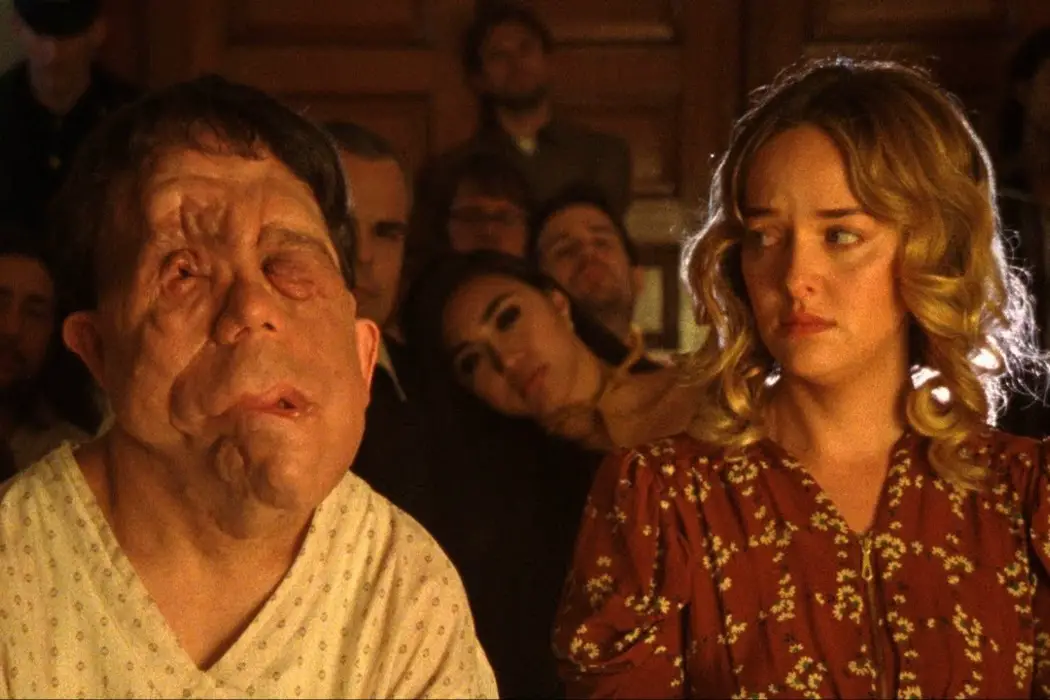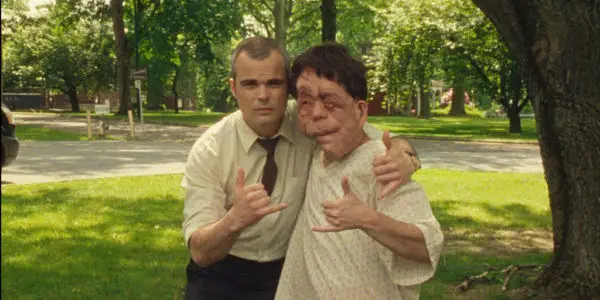Milwaukee Film Festival 2019: CHAINED FOR LIFE & THE HOTTEST AUGUST

Midwesterner, movie lover, cinnamon enthusiast.
Coverage of the 11th annual Milwaukee Film Fest opens with Aaron Schimberg’s Chained for Life and Brett Story’s The Hottest August.
Chained for Life (Aaron Schimberg)

Aaron Schimberg’s second feature, Chained for Life, opens, after a scrolling Pauline Kael epigraph that becomes the film’s target, on a tense medical procedure set somewhere in Europe of yesteryear — the thick-accented doctor seems to be doing facial reconstructive surgery while a blind blonde woman wanders into the operating room and spills a bunch of potion-filled vials. “Cut” is called, and we realize what we’ve seen is footage from the making of a film. This opening allows us to calibrate how to watch the rest of Schimberg’s film: at the beginning of any given scene, we can’t be sure if what we’re watching is a performance or not.
Chained for Life is particularly interested in performance as it relates to people with disabilities, films about them and the able-bodied that play them. It fits squarely in the sub-genre of films about filmmaking — it recalls Tom DiCillo’s Living in Oblivion, a similarly independent feature about filmmaking, and not only because of that film’s satirical use of Peter Dinklage’s character.
Here, the filmmaker, Herr Director (Charlie Kosmo) affects a suspicious Herzogian accent (which is even rumored to be fake) making his first English-language film — a figure of performance itself — that falls somewhere between disability exploitation and art horror. A bus load of folks that would make up a traditional circus of “freaks” (half-man, half-woman, giant man, little person, bearded lady, etc.) arrive to be in the film, most notably a man with neurofibromatosis named Rosenthal (Adam Pearson), who becomes the love interest of Mabel (Jess Weixler)’s blind blonde woman. Mabel, the film’s protagonist, is where Schimberg bases the core of his satire — her oblivious, naive view of Rosenthal becomes a sort of surrogate for the condescendingly kind and able-bodied.
In his post-film Q&A, Schimberg called his film something of an extension of Tod Browning’s 1932 film Freaks, which is unsurprising. More surprising is how much DNA he was able to pilfer from the catalog of Robert Altman, a director who multiple films about productions (be them film, radio, fashion show or ballet). I was constantly stunned by how effectively Schimberg was able to use Altman’s room-roaming camerawork and democratic audio, bopping from one conversation to another, or from one conversation to a backgrounded TV or curious onlooker. It’s quite lovely to see, both as a near-revival of a dead legend and as a technique that suits Schimberg’s diegetic film production, which itself becomes a tacit battleground for democratic storytelling.
What I don’t want to understate is how thoroughly funny Chained for Life is. Its narrative flow meanders, from quotidian on-set conversations to the film-within-the-film’s production to streams of dailies footage — all of which allow Schimberg to develop comedic rhythms not contingent on moving the plot forward. It also helps that he has Pearson, giving one of my favorite performances of the year, who brings his own casual, dry cadence.
Alongside just great comedy — a couple scenes of Herr struggling trying to get the right take and one monologue about Orson Welles’ appearance in The Muppet Movie among the highlights — Schimberg’s unhurried, bouncing pace and prickly jovial tone makes for a text that slowly collects layers of its aforementioned thoughts about performance and storytelling — who gets to tell certain stories and why they want to tell them — to reveal a film that, like many of Altman’s satires, is not easy to shake.
The film ends with a curious scene: the camera doesn’t move from Mabel’s face as she takes a taxi ride from the set, and she’s bombarded with the life story of a Nigerian immigrant, someone very removed from her own situation. The way Schimberg refuses to leave Mabel’s countenance, though the scene is played for uncomfortable laughs, is a powerfully loaded decision as we slowly see through Mabel’s feigned empathy and question whether her character has gone through any sort of development at all since the film’s opening.
The Hottest August (Brett Story)

Brett Story’s The Hottest August is a non-fictional mosaic made up of fragments of New York City during August 2017. Story sews together disparate people and disparate ideas into one piece to reveal a portrait of modern day life.
The film covers big, urgent topics like reverse white flight, the gig economy, climate change and capitalism — and how those leading the latter are unwilling to do anything about the former — without the need for such demarcations. It’s not an Issue documentary, but a film about how urban folk think about and live with these big issues on a daily basis.
I happened to pair this film with Ulrich Kohler’s In My Room, from this year, which turned out to be a brilliant double bill. The two films bounce ideas off of each other well: Kohler’s film is a fictional film about a man who experiences the loneliness of capitalism’s apocalypse, while Story’s documentary offers a look at that impending apocalypse and the dread and uncertainty many of us feel.
I’ve seen the film called a direct homage to Chris Marker and Pierre Lhomme’s 1963 Parisian portraiture Le joli mai. Not having seen that film, I can’t speak to that — although just on concept, it sounds like an apt comparison — but there’s another moment that also feels directly related to Marker’s work. Late in the film, Story shows a handful of New Yorkers during an eclipse. Some are using head-wear, some glasses, one kid is using a box, one man isn’t looking at all. The moment reminded me of Marker’s 1999 short E-clip-se, an eight-minute film of people in France experiencing the eclipse of August 11, 1999.
But Story lacks the playful wonder that seemed to naturally ooze from Marker — the type of sensibility that could make nearly anything interesting to watch. The Hottest August isn’t a chore by any means but has trouble balancing its tone, between Claire Coulter’s occasional and serious voice-over, the drab News from Home-esque shots of New York street life, and Story’s more pointed interview questions. Through all of it, there’s a curiosity, of daily observation, that has trouble meshing with interview questions like “Do you think racism still exists?” — a question she asks two white men in a bar that makes for the film’s weakest moment.
Does content like this matter to you?
Become a Member and support film journalism. Unlock access to all of Film Inquiry`s great articles. Join a community of like-minded readers who are passionate about cinema - get access to our private members Network, give back to independent filmmakers, and more.












